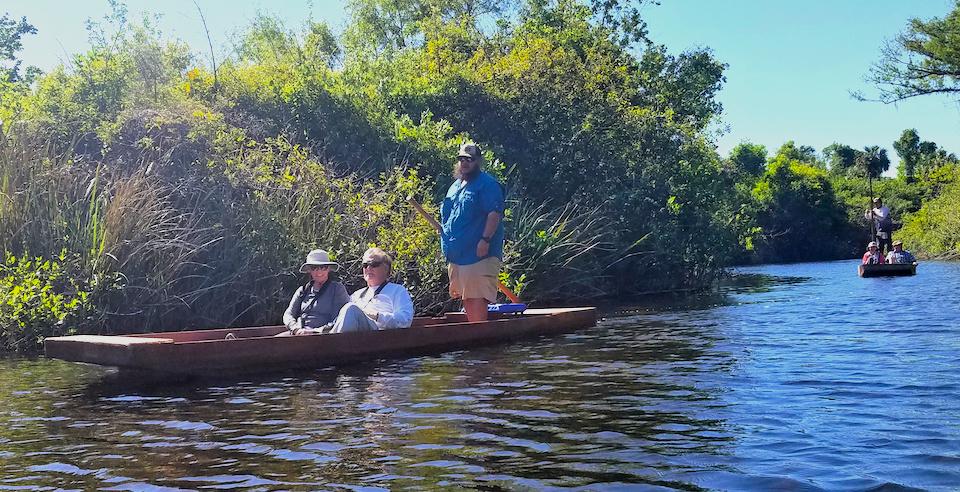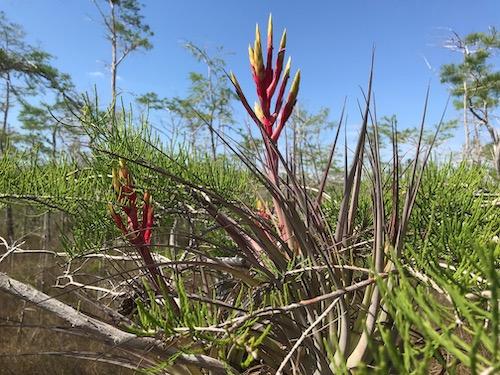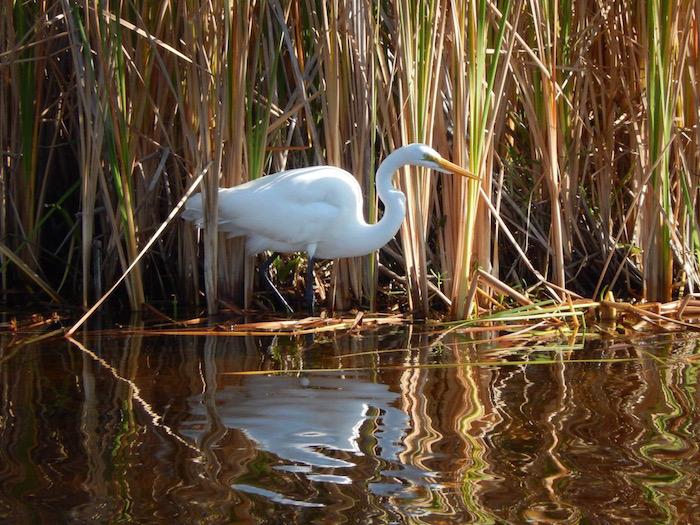
It’s an overcast day in March, and my shoes are wet. Not just damp, like I’ve dashed from the car to the house in the rain, but as wet as wet gets. I’m up to my ankles in a marl prairie—a freshwater prairie with water seeping in and across it—deep in the backcountry of Big Cypress National Preserve. Aside from the voices of my companions, the only sounds I hear are the wind rustling through the cypress trees, the calls and squawks of soaring birds, and my own sloshing steps.
Located just north of, and adjacent to, Everglades National Park in south Florida, Big Cypress is a critical part of the Greater Everglades Ecosystem. Here, water has traditionally sheeted across this land, slowly creeping south from Lake Okeechobee through Big Cypress and the Everglades—the vaunted “river of grass”—and finally into Florida Bay. My National Parks Traveler Editor Kurt Repanshek and I have come here to gain a greater understanding of the preserve’s unusual landscape and biodiversity, as well as the ongoing threats it faces.

Kim O'Connell and Kurt Repanshek explored part of Big Cypress by canoe/Kim O'Connell
As a national preserve, Big Cypress was born from compromise. In the 1960s, in response to plans to build a large jetport nearby, conservationists pushed for National Park Service protection for the swamp but faced opposition from those who wanted to retain access for various traditional uses. As a result, in 1974 Congress established Big Cypress National Preserve, the first of its kind in the United States, meaning that hunting, oil and gas extraction, off-road vehicles, private land ownership, local tribal activities, and cattle grazing were allowed to continue in the park. (There are now 19 national preserves in the National Park System, mostly in Alaska. Big Thicket National Preserve in Texas actually was authorized the same October day in 1974 as Big Cypress.)
Big Cypress encompasses five distinct habitats across its 729,000 acres—hardwood hammocks, pinelands, prairies, cypress swamps, and estuaries. These habitats support a wide range of plant and animal species, including river otters, American alligators, bobcats, fox squirrels, and black bears. Importantly, the preserve offers the largest contiguous habitat for the endangered Florida panther in south Florida. Hundreds of bird species can be seen at Big Cypress throughout the year, including the white ibis with its curved orange beak; the blue heron (actually gray-blue) with a black stripe over its eye; and the silvery-black anhinga with its sharp, dagger-like beak.
Our guide this morning is Melissa Abdo, Sun Coast regional director of the National Parks Conservation Association. We are tagging along with two ecologists who are surveying impacts from oil and gas exploration. As our group hikes deeper into the preserve, we see ORV paths crisscrossing the land and deep ruts left over from the ponderous, 30-ton seismic machines that test for oil and gas. The ruts allow for higher-than-normal standing water, which promotes the growth of both invasive plant species and unnatural monocultures of native ones. The scientists measure the depth of the standing water as well as how deep the ruts are below adjacent non-impacted soils, and compare that to previously gathered data, an exacting process that takes at least an hour at each monitoring spot.
“It’s a full-time job to examine a policy issue like this,” Abdo says. “We then take this analysis and translate it for the community.”
Abdo has a PhD in biology, and helped to create a botanical inventory of the preserve, so she knows this landscape about as well as anyone. As we pass a cocoplum tree, she plucks off a dark purple fruit about the size of a grape and hands it to me. “Try it,” she says, sounding like something out of Alice in Wonderland. I take a bite and enjoy its mildly sweet flavor, but the biggest surprise is that it’s white on the inside, like a coconut. “Chrysobalanus icaco,” Abdo says, offering the plant’s scientific name. She does this throughout the day, rattling off from memory the scientific names of the plants we see.
As we seek out a dry place to sit and eat some lunch, we learn more about the cypress trees for which the park is named—those flood-tolerant species whose trunks appear buttressed around the base and whose limbs are often heavy with Spanish moss and festooned with colorful epiphytes -- non-parasitic plants that grow on other plants or trees. Cypress trees grow in three distinct ways in the park—in cypress strands, where the trees form ribbons along rivulets of water; dwarf cypress forests, which, despite their relatively small size, are sometimes many hundreds of years old; and cypress domes, named for their shape as seen from a distance, with taller trees in the middle where water is deeper, and shorter trees on the drier edges.
Among the many species of epiphytes found in the park are 16 species of bromeliads, tropical plants that are related to pineapples. The most abundant of these is the cardinal airplant, whose bright-red bracts, which conceal growing flowers, are visible most of the year. With the bromeliads’ spiky, long leaves spilling out from trees in every direction, it looks like a wild hanging garden. Three dozen orchid species are also found in the preserve, including the ghost orchid, another epiphyte. One of the world’s most unusual orchids, the ghost orchid grows on both cypress trees and royal palms.
Eventually, we wind our way back to our starting point via a portion of the Florida National Scenic Trail, a 1,300-mile path that stretches from the Florida panhandle down to its terminus in Big Cypress. Abdo continues her informal botany lesson as we hike, pointing out a sweet-smelling showy milkwort (“Asemeia violacea,” she says, as I jot it down phonetically in my notebook, to look up later) and the bacopa (“Bacopa caroliniana”—this time Abdo just writes it in my book for me), whose leaves smell like lemon. From my nose and mouth to my sodden feet, it’s a feast for the senses.
The next day, with drier shoes on, and eager to experience more of the preserve, Kurt and I meet up with two park rangers to go paddling. We have come to a put-in site along the nearly ten-mile Turner River Paddling Trail, one of several canoe trails in Big Cypress. Kurt and I share a canoe, and the two rangers opt for single-person kayaks. As we paddle upstream, the sun glitters like fish scales on the water, and we pass anhingas, herons, and alligators, who use a strong flick of their tails to swim away when we approach.
We paddle over to a shadowy cove, where we spot what looks like a patch of chewed pink bubblegum stuck to a tree trunk. Upon closer inspection, we see that the patch is actually a conglomeration of tiny round eggs. The pink color is a dead giveaway, the ranger tells us, that these eggs belong to the island applesnail, an invasive cousin of the native Florida applesnail. The native snails (whose egg masses are white) are critical to the diet of the endangered Everglades snail kite, but have been outcompeted by the invasives, which reproduce at faster rates and grow much larger. To demonstrate, the ranger roots around along the shoreline and picks up an invasive snail shell nearly the size of her palm. The natives, by contrast, are about the size of a walnut.

Some explore the Turner River by traditional boats that are poled along/Kim O'Connell
The ranger poses a philosophical question to us. The invasive snails give the snail kite more food. So what should the National Park Service do? Remove the invasives, and a critical food source for an endangered bird along with them? Or keep them in the park, at the expense of their native counterparts?
It’s a question we can’t answer, at least not quickly, so we keep paddling. We turn around and head south, passing under U.S. 41—better known as the Tamiami Trail, which connects Tampa and Miami. Here, the river narrows, and the mangroves on either side, with their overhanging branches and exposed roots, come close enough for us to touch. We’re in a mangrove tunnel, and it feels like a portal to another world. The paddling is trickier through here, and we grow quiet. Eventually, we give up and tuck in our paddles, pulling our canoe through the water limb over limb, branch over branch, until we reach open water again.
At some point, the river enters Everglades National Park, where the canoe trail ends in Chokoloskee Bay, but we have to turn our canoe and head back. When it comes to resource management, the boundary line between the park and the preserve certainly matters. But out on the river, with the water lapping our canoe and the sun dappling our arms and faces, we are reminded that there is just one Everglades ecosystem—the only one we have.













Comments
Thank you for a beautiful journey and wonderful, descriptive prose to describe it. I felt like I was there. The ghost orchid is my obsession and I wrote a novel, Ghost Orchid, around that obsession set in Blair Audubon corkscrew Swamp Sanctuary. Your prose would step into my novel so well and I hope you write more about the Everglades. Best always, dkchristi www.dkchristi.com